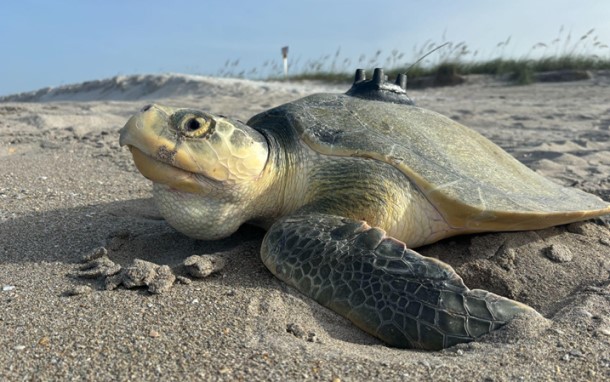Kemp's on the move!
Posted on May 19, 2025
Five Kemp’s ridley turtles satellite tagged on the east coast of Florida have moved out of Florida waters: one passing through the Strait of Florida before heading north and west along the coast as far as Louisiana, and four heading north to seasonal foraging habitats along the east coast, including one Kemp’s that has traveled into the Chesapeake Bay, north of Mobjack Bay, and another that has resurfaced in Pamlico Sound, North Carolina after a long gap in tag transmissions.
These migratory animals can give us important ecological insights into this understudied population. We know Kemp’s ridleys move north into seasonal foraging habitats along the east coast as waters warm based on previous tracking studies, stranding records, and at-sea sightings. However, the dive ecology of these animals as they make this migration is unknown and can have important implications for mitigating impacts both as they travel and where they settle to forage for the season.

A Kemp's ridley sea turtle heading back to the ocean with a satellite telemetry tag attached to it's carapace.
Kemp’s nest almost exclusively along the beaches of Mexico and Texas; however, each year, up to 26% of any hatching cohort is expected to travel through the Straits of Florida north along the US eastern coast. The animal traveling west in the Gulf is particularly interesting, as it contradicts the long-held assertion that Kemp’s ridleys that move into the Atlantic Ocean are “lost to the population”. This large juvenile (55cm) is on the cusp of reproductive maturity and may be returning to its home waters to reproduce. Understanding how animals from this endangered species move between basins is crucial to their long-term survival as threats must be mitigated at all life-stages and developmental habitats to ensure the continuation of the species, which acts as a keystone in coastal marine ecosystems.
 Tracks for five Kemp’s ridley sea turtles tagged earlier this year on the east coast of Florida. The satellite tags are still transmitting as of early May, except for the turtle off the coast of Louisiana, which ceased transmitting in mid-April.
Tracks for five Kemp’s ridley sea turtles tagged earlier this year on the east coast of Florida. The satellite tags are still transmitting as of early May, except for the turtle off the coast of Louisiana, which ceased transmitting in mid-April.
While the goal of this project is to produce availability bias estimates to support Navy environmental compliance efforts, the tag data are already producing valuable ecological insights useful to broader species conservation efforts, highlighting the importance of Navy research to the broader science community.
Animals tagged and sampled under Inwater Research Groups’ protected species permits including Florida permit number MTP-24-125B
Follow this project and Inwater Research Group on social media:
Instagram: www.instagram.com/inwaterresearch
Facebook: www.facebook.com/inwaterresearch
Website: www.inwater.org

